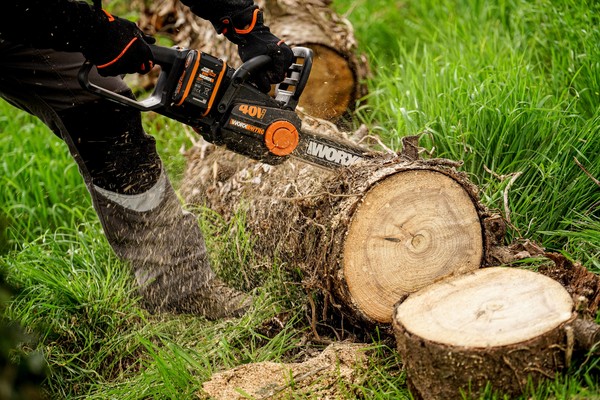
Chainsaws with internal combustion and battery-powered engines
Chainsaws have become an essential tool for a wide range of maintenance also in urban environments. Technological developments focus on lowering the machine's weight while keeping its power high. The highly versatile, environmentally friendly, quiet battery-powered chainsaw segment is rising
chainsaw market is evolving both in terms of demand and supply quality. In Italy, in the first months of the year, with a 7.8 percent drop in gardening machinery compared with the same period in 2021, a year, however, in which there had been a sharp upturn after the 2020 standstill, the reduction in the chainsaw market was only 5.4 percent. The drive toward increased tree planting in cities to cope with rising temperatures and increased environmental pollution is expected to further increase demand for these machines shortly, particularly from landscape managers. Broadly speaking, the elements that drive the choice of chainsaw are related to the device's primary use. The following are mainly considered: the machine's weight, the engine's power, handling and comfort in use, and the reliability and safety of service.
Chainsaws with an internal combustion engine
The almost universally adopted endothermic engine is the 2-stroke cycle engine, as it is light, constructionally very simple, highly reliable and relatively cheap. The fuel for these engines is a mixture of gasoline and oil.
These chainsaws can be subdivided according to the displacement and engine power to which the length of the chain bar that acts as the cutting blade is linked. High-powered professional machines have displacement above 70 cm3 and power ratings between 3.5 and 5.0 kW, to which cutting bars above 50 cm are attached. They weigh 6-7 kg. Specifically, those with a displacement above 80 cm3 are primarily used for felling trees from the base. Still for professional use are the medium-high displacement chainsaws, that is, with values between 50 and 70 cm3, for power outputs of 2.5-3.5 kW, having cutting lengths up to 50 cm and weight around 5 kg. Again intended for professionals but also for hobbyists are the chainsaws with medium-low displacement, between 30 and 50 cm3, with the power of 1.5-2.5 kW and weight in the range of 4 kg. Below 30 cm3, there are the chainsaws referred to as lightweight, used in pruning olive and fruit trees and also by hobbyists. The evolution of the construction of these chainsaws has been mainly directed toward weight reduction. This has been achieved through new materials and the construction of smaller, less heavy cylinders, which have been combined with the greater efficiency of the new engines. This has resulted in machines lighter than in the past that perform better and have an excellent power-to-weight ratio. As an example, today's chainsaws with a 50-cm3 displacement provide the same performance as the 60-cm3 ones of 5-6 years ago. Electronic power management has been used to increase engine efficiency, including acting on improving the oil-fuel mixture. Work was also done on the ergonomic aspects, reducing hand-arm vibrations and noise and also serving on the search for the best balance of the vehicle to make it more maneuverable and less tiring to operate. Enhancements have also been brought to the chain by increasing its cutting performance and improving its lubrication. For chainsaws, too, it is possible to have machine geolocation and diagnostic system for remote analysis, maintenance, and repair. However, these solutions are more meaningful for fleet management. Since European regulations for small endothermic engines require the implementation of the Euro 6 standard and also noise reduction by 2025, manufacturers are preparing to adequately meet these restrictions, with some focus on the battery-powered solution.
Battery-powered chainsaws
The market for battery-powered chainsaws is constantly evolving, partly under the thrust of growing demand. There are several explanations for this. First of all, the improved lithium-ion batteries, which have become increasingly high-performance, are capable of ensuring a long service life with increasingly shorter charging times. As a matter of fact, the operating range of the latest generation machines can reach and exceed even 8-10 hours of work, thus covering the time span of an entire day. Some models have a built-in charge level measurement system to assist the operator, which transmits a signal when it reaches 10 percent of the maximum load. In addition to this, there has been an improvement in the construction of the machine, which has become increasingly lighter (on average, the weight is 60-70% of an equal model with an internal combustion engine), easy to handle and ergonomic. A push-button operates starting, and hand-arm vibrations are very low during use, benefiting the reduction of musculoskeletal diseases in professional operators. Indeed, the vibration reduction at the handle level in battery-powered machines compared with the endothermic version of the same power is about 1 m/s2. There are no CO2 emissions during use, and noise is lower than that produced by chainsaws with endothermic engines. This lower impact makes the machine more suitable for use in places visited by the public or extremely sensitive, such as hospitals or nursing homes may be. With improved engine performance and blade speeds of 20 m/s or more, battery-powered chainsaws provide absolutely comparable performance to those with internal combustion engines. Models with lower power, 1-1.5 kW, have a cutting length of 15-20 cm, while those with higher power reach cutting lengths of 40 cm. A battery-powered chainsaw with a 15 cm cutting length and 1.2 kW power performs as well as the 30 cm3 petrol version. Similarly, the machine with a 40-cm cutting bar is equivalent to the 40-cm3 petrol engine version.
Care and safety of use
Regardless of the type, special care should be taken with the chainsaw. Specifically: cleaning should be practiced after each work session; the cutting chain should constantly be lubricated and ready for use; the sharpening of the chain teeth should always be checked, just as the chain tension should always be checked (a chain that is too tight risks breaking, one that is not tight risks pulling apart). Personal protective systems should not be neglected. That is, it is necessary to use: cut-resistant protective gloves; safety glasses or visors; a protective helmet, headset or earphones; protective breeches and boots. It is important to remember to keep the machine off during transfers by inserting the blade into the protective sheath.
Again to enhance the safety of use, some manufacturers participate in and promote classroom and field training courses, also making use of new educational technologies, such as the use of virtual reality, using pruning and tree felling simulators.








